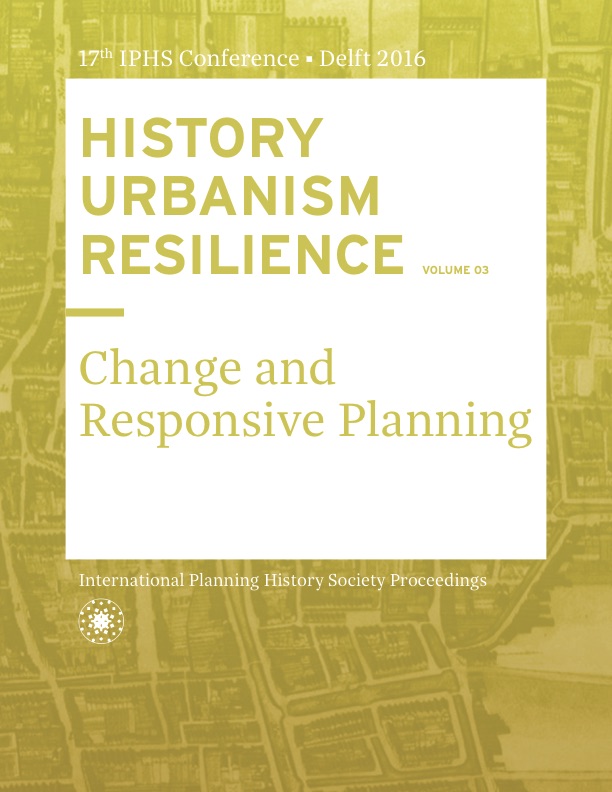Lisbon - between resilience and change: from the 1755 earthquake to the 1988 Chiado fire
DOI:
https://doi.org/10.7480/iphs.2016.3.1273Abstract
With this paper, we intend to emphasize the resilient role of the city of Lisbon destroyed by the appalling Earthquake on 1 November 1755. Reconstructed in the eighteenth century by order of the Marquis of Pombal, it was one of the earliest cities transformed under the aegis of the Enlightenment through a complete modern plan.Contemporary Lisbon identity is defined through the contrast between the rationality of Pombal´s plan - characterized by an orthogonal grid and a regular and homogeneous architecture - and the organic character that remained in the neighbourhoods resistant to the earthquake as well.
With urban expansion to north, this identity consolidates in the nineteenth and twentieth centuries, through the opening of new streets and avenues and the creation of new neighbourhoods.
On 25 August 1988, the center of Lisbon is once again strucked by a major disaster: a devastating fire destroyed Chiado, one of the most city’s distinctive areas of the.
In the aftermath of Postmodernism debates, the period during which the municipal authorities reflected upon the best approach, several personalities related to architecture and culture as well civil community discussed the future of the affected area. Such a debate was polarized by two opposing views: the rebuilding of the destroyed buildings as they originally, or alternatively, the construction of new buildings with a new design expressing their own time and refusing a historicist pastiche.
The assignment of the project to Álvaro Siza Vieira put an end to the debate and gave rise to a new controversy. Siza proposed neither the full reconstruction of the pre-existing buildings nor a radical break with the past. He proposed instead a compromise solution based on the thesis that the affected area integrates a larger unit – the so called Baixa, the lower part of the city reconstructed under Pombal´s orders – which, as a "big building", should be "repaired" in order to preserve its identity.
Siza addressed a very personal interpretation of Lisbon. His plan rests upon on a thorough study of the Pombaline building system that ranges from the urban layout to the composition of facades, not to mention the details of doors and windows. Although there was not a guarantee for the success of the operation and the risk of urban mischaracterization was real, after the early years marked by uncertainty, Chiado was reborn to become one of the liveliest and vital areas of Lisbon.
Through multidisciplinary approach, we do not only intend to reflect on the urban history of Lisbon, but also to demonstrate that Siza´s reconstruction, which started in 1988, managed to reinterpret and to continue the 1755 plan, which has ensured the resilience of Lisbon´s identity facing an increasingly globalized world.
References
Colenbrander, Bernard. Álvaro Siza e a Estratégia da Memória. Catálogo da exposição O Chiado. Lisboa. Álvaro Siza e a Estratégia da Memória. Granada e Lisboa. Delegación em Granada del Colegio de Arquitectos, Dirección General de Arquitectura y Vivienda, Sociedade Lisboa 1994. 1994: 95-107.
França, José Augusto. A Reconstrução de Lisboa e a arquitectura pombalina. Lisboa, Instituto de Cultura e Língua Portuguesa - Colecção Biblioteca Breve - Volume 12. 1989.
França, José Augusto. Lisboa: Urbanismo e Arquitectura. Lisboa, Instituto de Cultura e Língua Portuguesa - Colecção Biblioteca Breve - Volume 53, 2.ª Edição. 1989.
Gomes, Paulo Varela. A Cultura Arquitectónica e Artística em Portugal no Séc. XVIII. Lisboa. Editorial Caminho, 1988.
Rossa, Walter. No 1.º Plano. Catálogo da exposição 1758 Lisboa: O Plano da Baixa Hoje. Lisboa. Câmara Municipal de Lisboa, 2008: 24-81.
Salgado, Manuel. Do Plano de reconstrução de 1758 à Revitalização do Século XXI. Catálogo da exposição 1758 Lisboa: O Plano da Baixa Hoje. Lisboa. Câmara Municipal de Lisboa, 2008: 232-247.
Silva, Raquel Henriques da. Lisboa Reconstruída e Ampliada. Catálogo da exposição 1758 Lisboa: O Plano da Baixa Hoje. Lisboa. Câmara Municipal de Lisboa, 2008: 126-167.
Siza, Álvaro. Estratégia da Memória. Catálogo da exposição O Chiado. Lisboa. Álvaro Siza e a Estratégia da Memória. Granada e Lisboa. Delegación em Granada del Colegio de Arquitectos, Dirección General de Arquitectura y Vivienda, Sociedade Lisboa 1994. 1994: 71-77
Tostões, Ana. Precursores do Urbanismo e da Arquitectura Modernos. Catálogo da exposição 1758 Lisboa: O Plano da Baixa Hoje. Lisboa. Câmara Municipal de Lisboa, 2008: 168-229.

